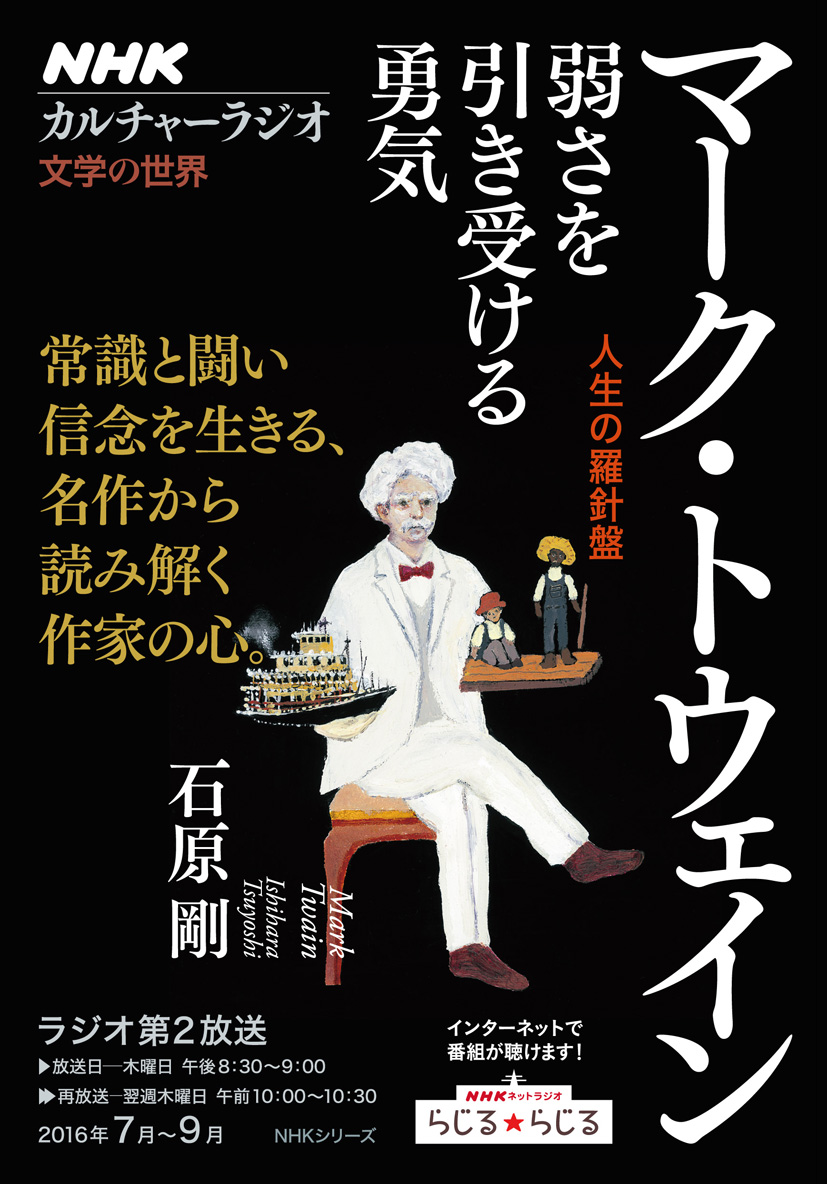
Title
NHK Culture Radio, The World of Literature Mark Twain: Jinsei no Rashinban (Mark Twain: The Compass of Life – The Courage to Accept Weakness)
Size
178 pages, A5 format
Language
Japanese
Released
June 25, 2016
ISBN
978-4-14-910939-8
Published by
NHK Publishing, Inc.
Book Info
Japanese Page
This book has been prepared as the textbook for NHK’s radio program, “Culture Radio: The World of Literature,” broadcast on NHK Radio 2 in 2016. The textbook consists of 13 chapters according to the number of episodes broadcast on the radio. It introduces the life and literature of Mark Twain (1835–1910), the iconic national writer of nineteenth-century America, and his relationship with American history and culture. Twain was greatly revered as a canonical author, the founder of American literature, and was a favored humorist, almost the equivalent of today’s star comedian. His life was closely tied to contemporary American history. He grew up in a village by the Mississippi river, worked as a steamboat pilot on this mighty river, participated in the Civil War for a short time, moved to the West on a stagecoach in the heyday of frontier expansion, and became known as a newspaperman in a wild mining town during the Silver Rush in the Far West. After moving back east he wrote numerous stories, including a bestselling travelogue that liberated Americans for the first time from their inferiority complex toward European cultures, The Adventures of Tom Sawyer and Adventures of Huckleberry Finn, whose protagonists were perhaps two of the most popular American boys in literature, imaginative science fictions whose protagonists travel in time and space, and a detective story in which fingerprinting contributes to solving the mystery. He even privately published a short story in which celebrities of Elizabethan England enjoy having fireside conversations about sex. In public, on the other hand, he severely criticized America’s imperialist policy exemplified by its invasion of the Philippines, as a result of which he was detested by expansionists, including the US President of the time. In his later days, he was heavily in debt because of failed speculative ventures and publication businesses, and suffered a string of deaths in his beloved family. At the same time, he was much applauded when he succeeded in repaying all his debts after a painstaking round-the-world lecture tour. By the time Twain died at the age of 74, his image as the embodiment of American conscience had already been established.
Discussing his dramatic life and best-known stories, such as The Adventures of Tom Sawyer, The Prince and the Pauper, Adventures of Huckleberry Finn, and What Is Man?, this textbook reveals that his courage in facing up to the weakness of mankind is essential in understanding his literature and humor, particularly Adventures of Huckleberry Finn, one of the representative works not only of Twain but also of American literature. The issues of race and conscience in this American classic are carefully examined in four chapters of the textbook. The last chapter deals with the Japanese reception of Twain since the Meiji period. It shows what the Japanese expected to acquire from this iconic American author with references to a variety of Japanese translations and adaptations. Kenzaburo Oe’s encounter with Huck Finn is also discussed in this chapter. Each chapter concludes with Twain’s insightful maxims that touch the core of human life.
Thus, the textbook shows that Twain’s dynamic life and literature are significantly revealing, when we reflect upon sometimes contradictory issues of life, such as joy and sadness, courage and struggle, freedom and loneliness, and justice and prejudice. Once you start reading this textbook, you will find it difficult not to pick up Twain’s works that are waiting for you at bookstores.
(Written by Tsuyoshi Ishihara, Associate Professor, Graduate School of Arts and Sciences / 2019)



 Find a book
Find a book

